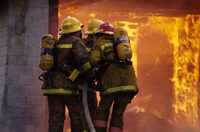 Fire safety is an issue that no firm can afford to ignore. If you let risk management standards slip when it comes to this issue, the consequences could be disastrous for your personnel, premises, finances and reputation. The fact is, the majority of blazes are preventable, as long as you adopt the right procedures and controls. To help ensure you’re able to keep danger levels to a minimum, here is a brief guide to fire safety in the workplace.
Fire safety is an issue that no firm can afford to ignore. If you let risk management standards slip when it comes to this issue, the consequences could be disastrous for your personnel, premises, finances and reputation. The fact is, the majority of blazes are preventable, as long as you adopt the right procedures and controls. To help ensure you’re able to keep danger levels to a minimum, here is a brief guide to fire safety in the workplace.
Ensure your personnel are in the know
Effective manager and worker training is a crucial aspect of fire safety. As an employer, you must make sure that your personnel know how to reduce risks and what to do in the event of an emergency. As well as in-house training, you can sign your staff up to courses run by expert third-party providers. The NEBOSH fire safety certificate is a good example. It is intended for managers, supervisors and employee representatives and it aims to enable people to boost fire safety in accordance with international best practice.
Conduct risk assessments
Another of your major responsibilities is to conduct fire safety risk assessments, and to keep these documents up to date. These analyses can be incorporated into broader risk assessments or conducted as a separate exercise. However you structure your assessments, they will need to identify potential cases of fire, substances that burn and any people who may be at risk if a blaze broke out at your premises.
As well as highlighting the dangers, you will need to determine appropriate actions to avoid them or, if this is not possible, at least control them. For example, your assessment may identify the need to keep flammable substances and sources of ignition apart, and to avoid accidental blazes caused by incidents like heaters being knocked over.
The importance of good housekeeping should also feature in your assessment. This may include the importance of avoiding the build-up of rubbish that could be a fire risk. In addition, you will need to specify what you will do to protect people if there is a fire. This will include fire detection and warning systems, the equipment needed to fight blazes effectively and making sure escape routes and fire exits are well marked and kept clear at all times.
Meanwhile, don’t simply shelve your assessment once it is complete. You will need to review and update it on a regular basis in order to ensure that it reflects all of the risks within your workplace.
Seek guidance if necessary
If you’re not sure about anything connected to fire safety, make sure you seek suitable guidance. There is plenty of information available online from official sources such as the Health and Safety Executive and, if you don’t have the time or confidence needed to deal with these issues yourself, you can bring in safety consultants to make sure you fulfil your obligations. This can give you added peace of mind.
As long as you take the risk of fire seriously and follow advice like this, you should be able to protect your employees and your business from this danger.
Author bio
This article was provided on behalf of SHEilds who offer the NEBOSH International Certificate in Fire Safety and Risk Management: www.sheilds.org/nebosh-international-fire-certificate/